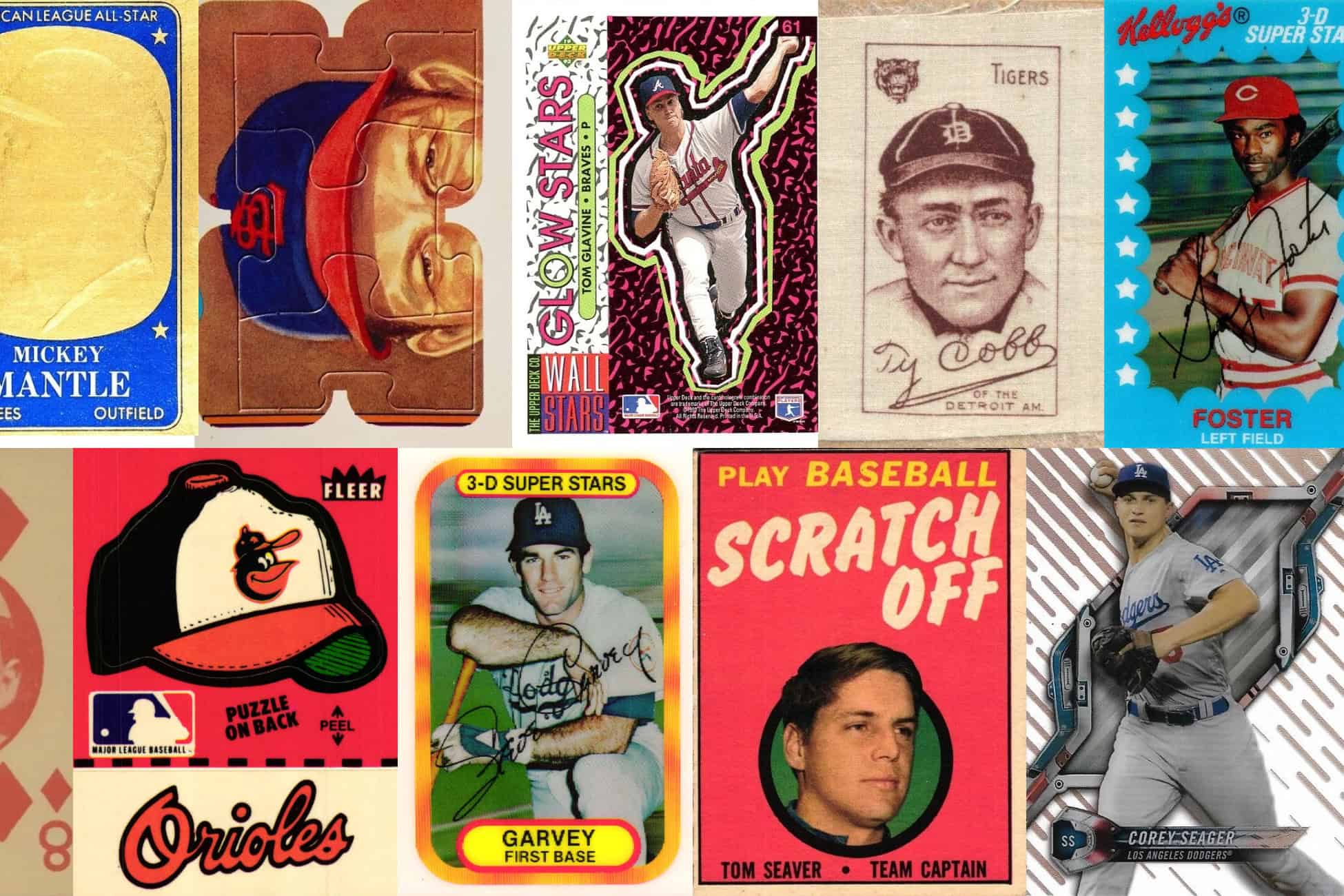Baseball cards are a tradition rooted in cardboard, statistics, and photography. But every so often, the industry veers off the beaten path. Collectors call them gimmick baseball cards – weird cards with wild printing techniques, tactile textures, moving images, or offbeat mechanics. Some were marketing stunts. Others were bold experiments. All of them reflect a time when card companies took creative risks to grab attention.
Today, these cards feel oddly charming. They don’t always fit in nine-pocket pages, but they stand out in a collection. From lenticular illusions to scratch-off game cards, let’s explore some of the most inventive gimmick baseball cards in baseball history – how they were made, how collectors reacted, and why they remain fascinating decades later.
Lenticular Cards: The Illusion of Motion
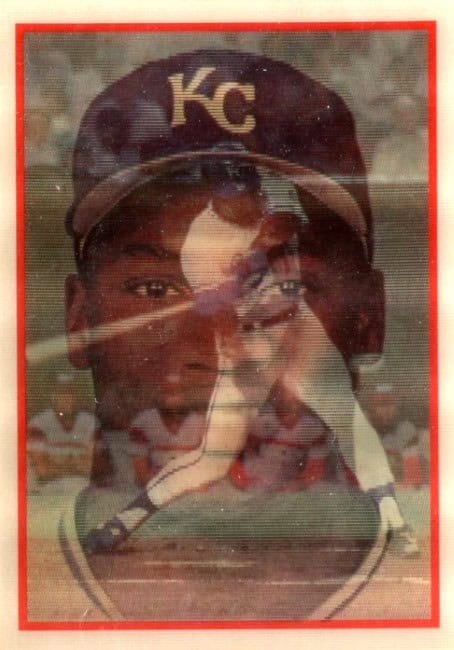
Lenticular cards became popular for their ability to change appearance when viewed from different angles. Most use a plastic lens overlay, made of ribbed plastic, that refracts light to display alternating images.
How They’re Made
The process involves printing multiple images onto a single sheet and aligning them with a lenticular lens. This lens consists of fine ridges that refract light in a way that each eye sees a different image depending on the angle. Manufacturers can achieve basic image flips, 3D depth, or even brief animations.
Lenticular technology has been around since the 1940s, but it entered the card world in the 1960s and 1970s with Kellogg’s 3D cards. In baseball, these cards appeared as cereal box premiums from 1970 to 1983, with each year showcasing players in dynamic poses, often with a 3D effect.
Collector Response
At the time, lenticular cards felt futuristic. The 3D effect turned static portraits into lifelike illusions. Kids loved them. They were tactile, visually striking, and very different from traditional flat paper cards.
Modern collectors still cherish Kellogg’s cards for their charm, although many suffer from cracking due to the plastic’s aging. Despite that flaw, a clean Kellogg’s 3D card remains a sought-after oddball gem.
Why They Matter
Lenticulars showed that cards could move – or at least appear to. The technology saw revivals in sets like 1995 Sportflix, 2000s Topps Opening Day inserts, and Topps’ modern “Motion” cards. They remind us that baseball cards aren’t limited to snapshots – they can tell stories in motion.
Scratch-Off Cards: Cardboard Meets Interactivity
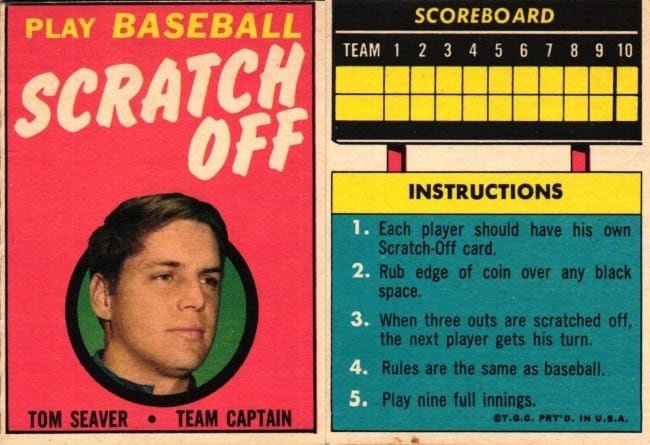
Few gimmick baseball cards were as interactive as scratch-off game cards. These cards turned the hobby into a hands-on experience, with results hidden beneath a scratchable coating.
Origins and Production
Topps introduced scratch-off cards in the early 1970s, with game inserts in 1970 and 1971 sets. Each card featured a simulated baseball field and a grid of scratch-off dots. Players could use a coin to reveal outcomes like “single,” “out,” or “home run.” The goal was to simulate a baseball game by scratching off one result per at-bat.
The scratch-off coating was a waxy material that could be easily removed but wasn’t meant to last. Most scratch-offs today show heavy wear – especially if used as intended.
Collector Reactions
These were wildly popular with kids. They gamified collecting, allowing young fans to play “real” baseball games with cards. The novelty wore off quickly, though, and scratched cards lost their value once used.
Today, unscratched versions are rarer and more desirable. They give collectors a glimpse into how the card was originally designed and preserve the piece’s original intent.
Scratch-Offs Today
Modern scratch-off cards mostly appear in contests, such as Topps’ online redemption games or promotional tie-ins. The pure game-card experience has faded, but the idea still shows up in special releases. Some Panini products and minor league team sets have used scratch-to-win inserts.
Scratch-offs represent a moment when baseball cards wanted to be more than visual – they aimed to be interactive, something you could play with, not just look at.
Glow-in-the-Dark Cards: A 1990s Neon Flashback
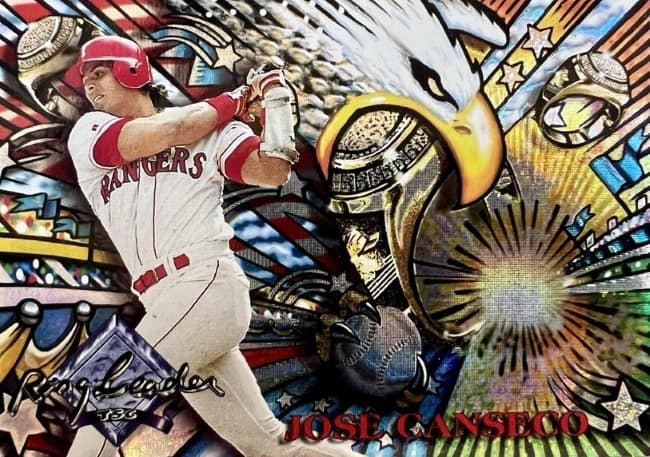
The 1990s brought a wave of experimentation, and few inserts embody the era better than glow-in-the-dark cards. Loud, strange, and purely for fun, these cards lit up – literally.
How They Work
Glow cards use phosphorescent ink. During printing, a special ink mixture containing phosphor pigments is applied to the card surface. These pigments absorb light (usually UV or sunlight) and slowly release it, producing a greenish glow in the dark.
These inks require curing and proper layering, which adds cost. Because of the gimmicky nature, glow-in-the-dark cards were often limited to inserts, not base cards.
Notable Releases
One standout example is the 1995 Topps Stadium Club “Ring Leaders” insert set, which glowed thanks to “Power Matrix” technology; 1997 Score “The Franchise;” 1993 Upper Deck “Fun Pack” stickers; and 1993 Pacific “Say No to Drugs” cards. More recently, 2024 Topps Now created a card of that year’s Solar Eclipse, which glowed green in the dark.
Collector Reception
Reception was mixed. Kids were dazzled, but many older collectors dismissed glow cards as novelty items. They weren’t rare or valuable, and most collectors didn’t store them in dark places to show off the feature.
Today, glow-in-the-dark inserts hold nostalgic value. They reflect the ’90s willingness to try almost anything and appeal to the collector who appreciates whimsy and nostalgia over book value, but they’re not common today.
Rub-Off Tattoos, Stickers, and Transfers
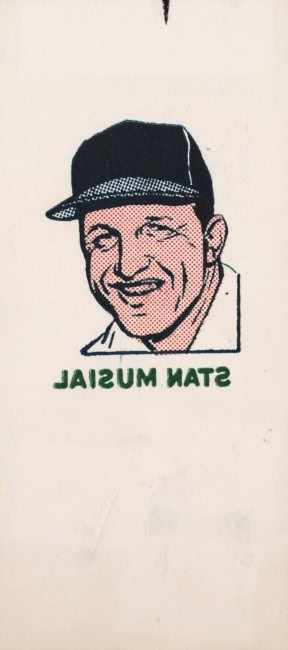
Cards weren’t always meant to stay on cardboard. Several sets blurred the line between cards and temporary body art, offering rub-off tattoos, sticker inserts, and iron-ons.
Key Examples
Topps experimented with temporary tattoos as early as the 1960s. In 1960 and 1961, they released stamp-like tattoos of players. In 1971, Topps issued transfer stickers that collectors could rub onto school notebooks, binders, or even skin.
Sticker cards reached a peak in the 1980s, especially with Topps Sticker Yearbooks. Kids could peel and stick players into printed albums, offering a combination of collecting and crafting.
How They Were Made
Most rub-on tattoos and transfers were printed in reverse on a coated sheet. When pressed and rubbed against a moist surface, the ink transferred. Stickers used die-cut adhesive backing and a peelable surface.
Printing and die-cutting these cards added complexity. They required materials that wouldn’t degrade over time, and the adhesive had to be strong enough to stick but not damage the backing card.
Collector Viewpoints
Tattoo and sticker cards often don’t survive intact. Many were used, making unused examples desirable among oddball collectors. The value lies in condition and novelty. While they rarely command high prices, they add variety to a collection and often spark conversation.
Their greatest strength? They were fun. They turned cards into activities, not just collectibles. That spirit still resonates today, especially for those who remember decorating school binders with sticker cards of their favorite players.
Cloth Cards and Fabric Stickers
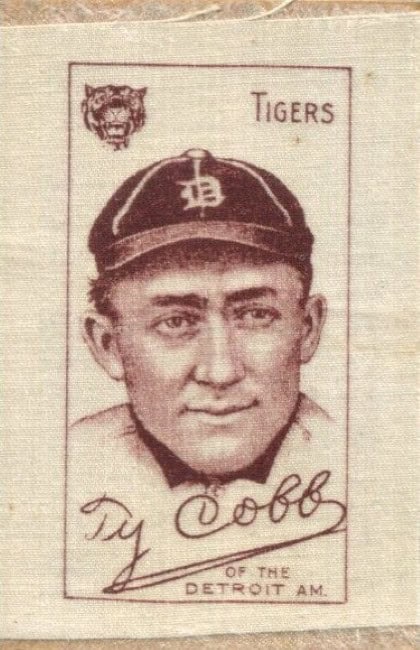
Some cards tried to mimic the look and feel of real jerseys long before relic cards. Cloth stickers and fabric-surfaced cards created a unique tactile experience.
A Fabric-Like Feel
Silk tobacco cards emerged in the 1910s. Sets like 1911 S74 were made of cloth, but served a similar purpose as cardboard cards – to sell tobacco. They often have creases or stains, but are otherwise highly sought after.
Topps experimented with cloth cards in 1977. These cloth stickers featured real players but printed on a soft fabric material with adhesive backs. The cards were sold in separate packs and marketed as an alternative to paper cards.
In the 2000s, relic cards with embedded game-used jersey swatches became the high-end evolution of this concept. But the 1977 cloth stickers remain a charming early attempt.
Making a Cloth Card
Cloth cards are typically screen-printed onto thin polyester or cotton layers and then laminated or cut to size. If meant to be stickers, a peel-off adhesive layer is added.
These production techniques were more expensive than regular printing. That’s why cloth cards were often shorter runs or special promotional products.
Modern Perception
Cloth cards occupy a unique space. They aren’t as valuable as relics, but they predate the memorabilia card boom. Collectors enjoy them for their distinct texture and nostalgic look.
Condition matters greatly. Fraying edges, creases, and dirt can reduce their appeal, so finding clean, unused versions is a challenge. Still, they’re a reminder that card companies have always experimented with materials to surprise collectors.
Other Gimmick Baseball Cards That Deserve a Mention
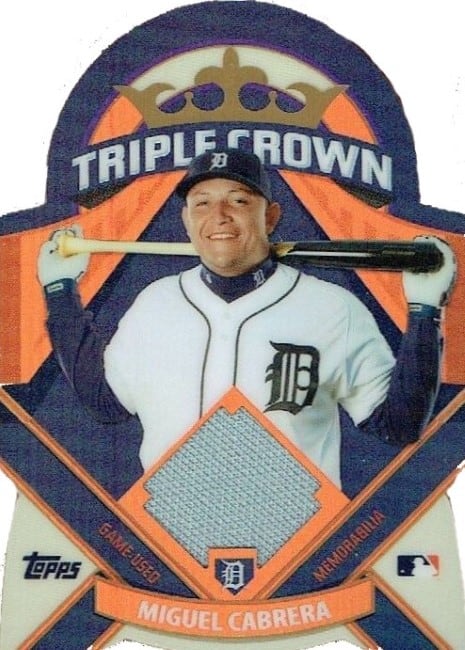
Several other card experiments deserve brief spotlighting:
Pop-Up Cards
The 1930s saw pop-up cards come onto the scene, with different versions allowing collectors to fold or pop-up their favorite players. The 1980 Topps Superstar Pop-Ups folded open into a stand-up player cutout. They were a novelty, not widely collected at the time, but have gained oddball status today.
Hologram Cards
1990s Upper Deck sets introduced holograms with 3D laser-etched images. They added security and visual appeal, leading to premium sets like 1993 SP. The technology is still widely used today, in different forms, on baseball cards.
Embossed & Debossed Cards
Cards with raised textures appeared in the mid-’60s, with a Topps set that featured embossed player profiles. This became a more common sight in the 1990s, when foil and textures became prominent in the hobby.
Die-Cuts
Cards cut into unique shapes became trendy in the late 1990s. They’re harder to grade, but fans love them for breaking the mold of rectangular designs. These are still used in the hobby, with recent sets like 2025 Bowman Rookie of the Year Favorites and 2024 Panini Prospect.
Clear Acetate Cards
These are printed on transparent plastic instead of traditional cardstock, giving them a sleek, modern look. Introduced in the 1990s and popularized in sets like Topps Tek and Upper Deck Clear Vision, these see-through cards are known for their durability and striking visual appeal. Collectors prize them for their innovation and high-end feel.
These gimmicks reflect decades of innovation – some successful, some short-lived – but all part of the hobby’s history.
Why Gimmick Baseball Cards Still Matter
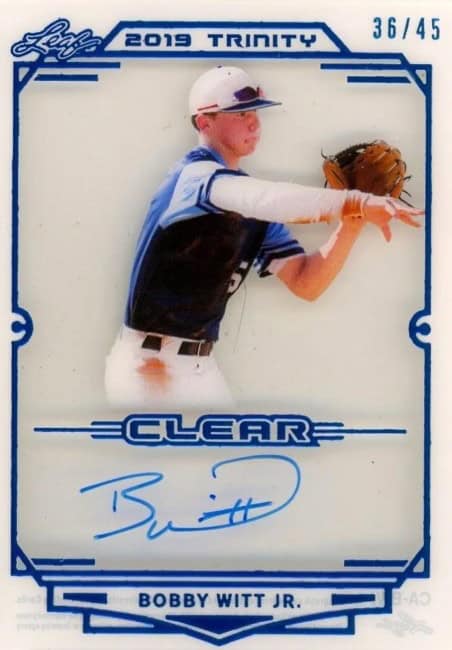
Gimmick cards remind us that baseball cards are more than just stats and headshots. They represent a tactile and imaginative form of collecting that invites play, surprise, and nostalgia.
For older collectors, they spark memories of cereal boxes, sticker albums, and summer games scratched out with a coin. For new collectors, they offer something different in a world of glossy autographs and serial-numbered inserts.
They’re not always worth money. Many have warped, cracked, or been rubbed raw. But that’s part of their appeal. They’re imperfect, tactile, and fun – and that makes them memorable.
Final Thoughts: Oddball Cards with Staying Power
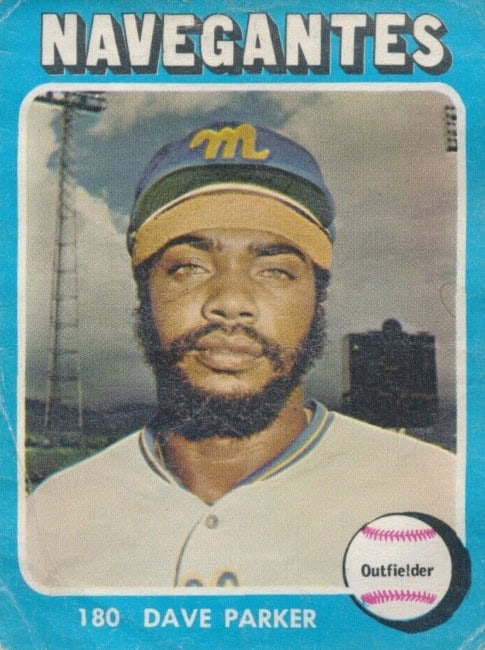
Not every gimmick card succeeded. Some were ignored. Others failed due to poor materials or awkward designs. But all of them shared a spirit of experimentation that pushed the boundaries of what a baseball card could be.
In today’s collecting environment, that spirit still lives on. You’ll find lenticular motion cards in Topps packs, sticker books in retail aisles, and scratch-offs in digital apps. Even glow-in-the-dark cards make the occasional return.
Gimmick cards are reminders that the hobby has always evolved, not just through technology or money, but through creativity and risk-taking. They’re weird. They’re wonderful. And they still have a place in binders across generations.
